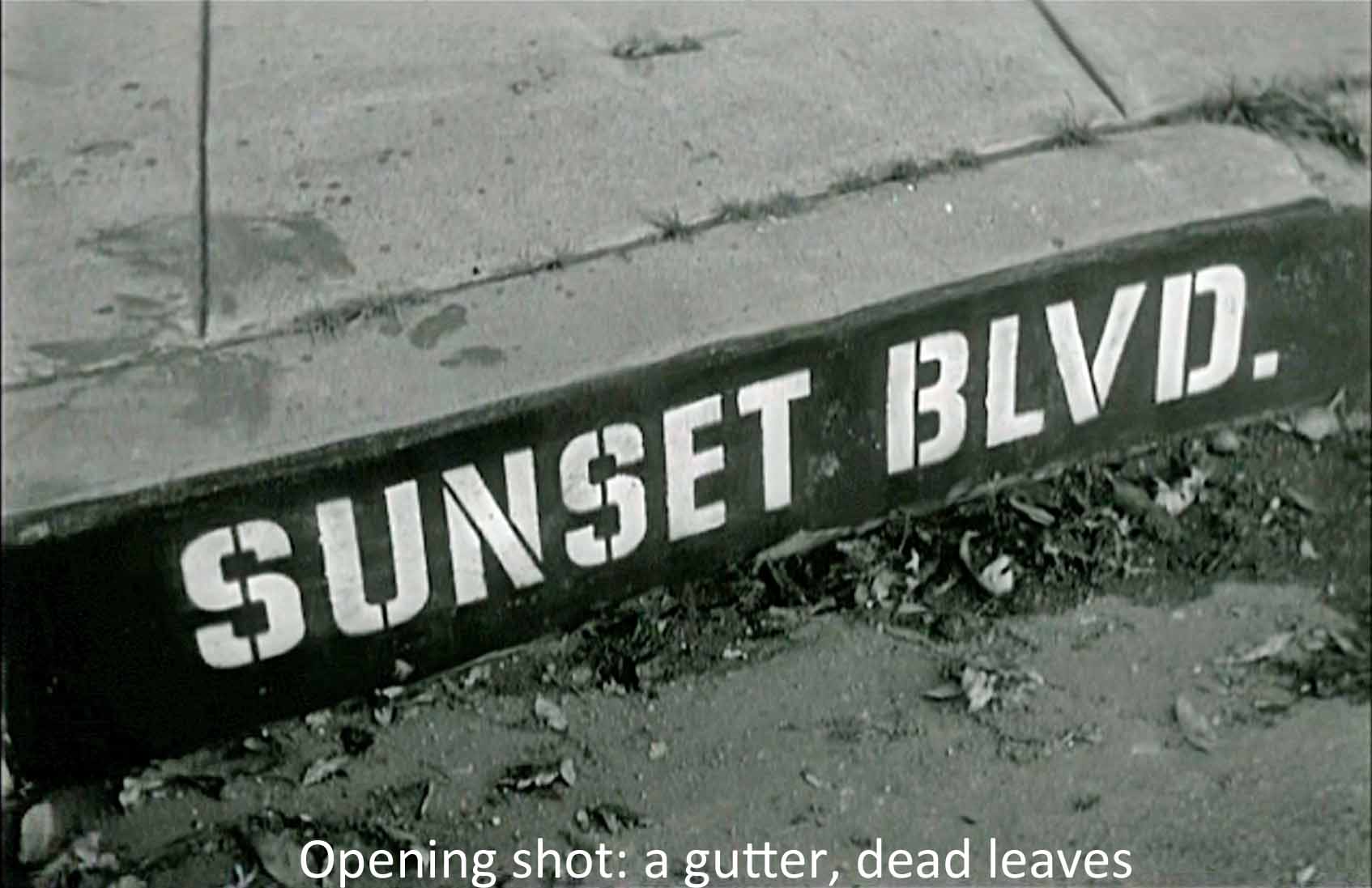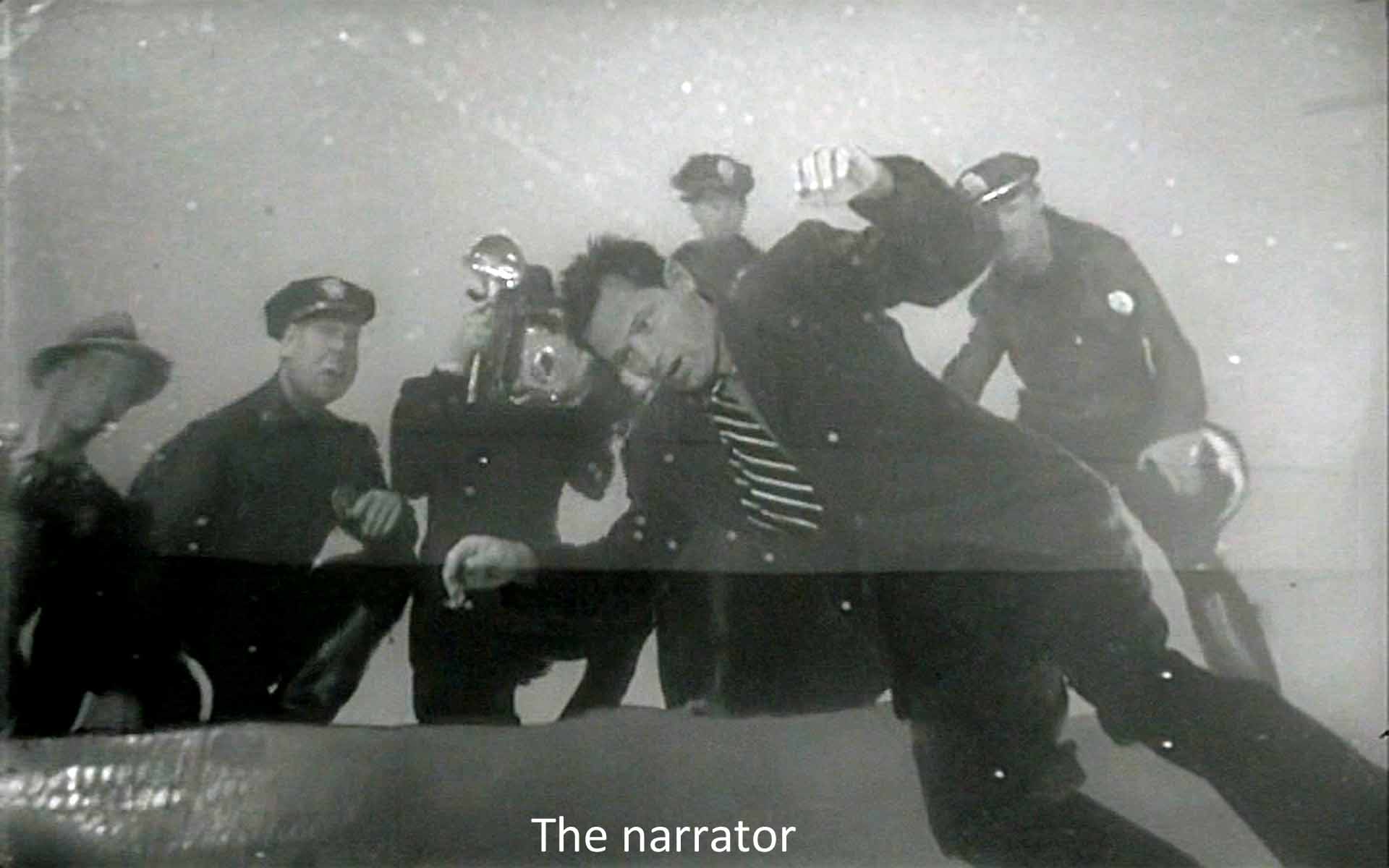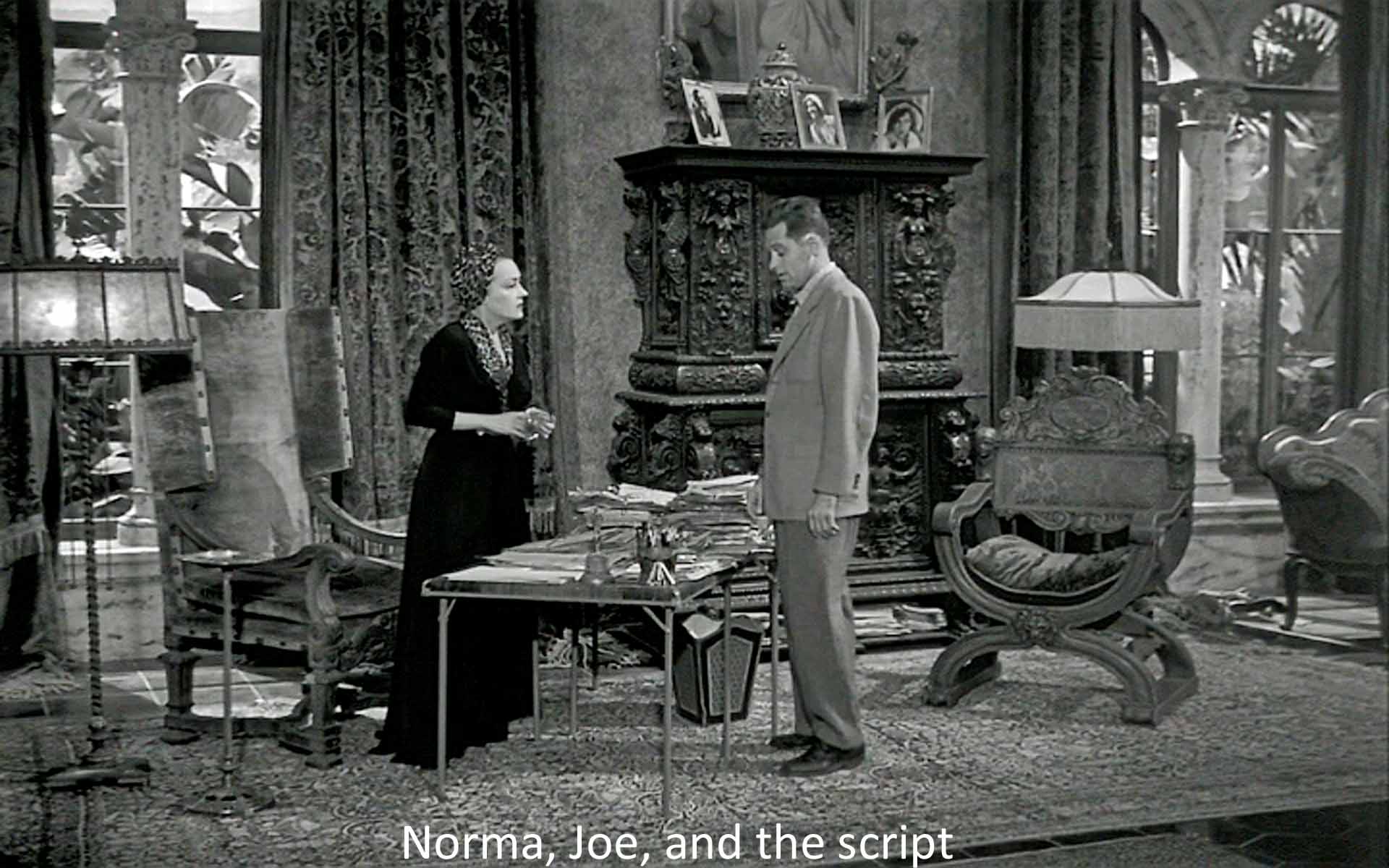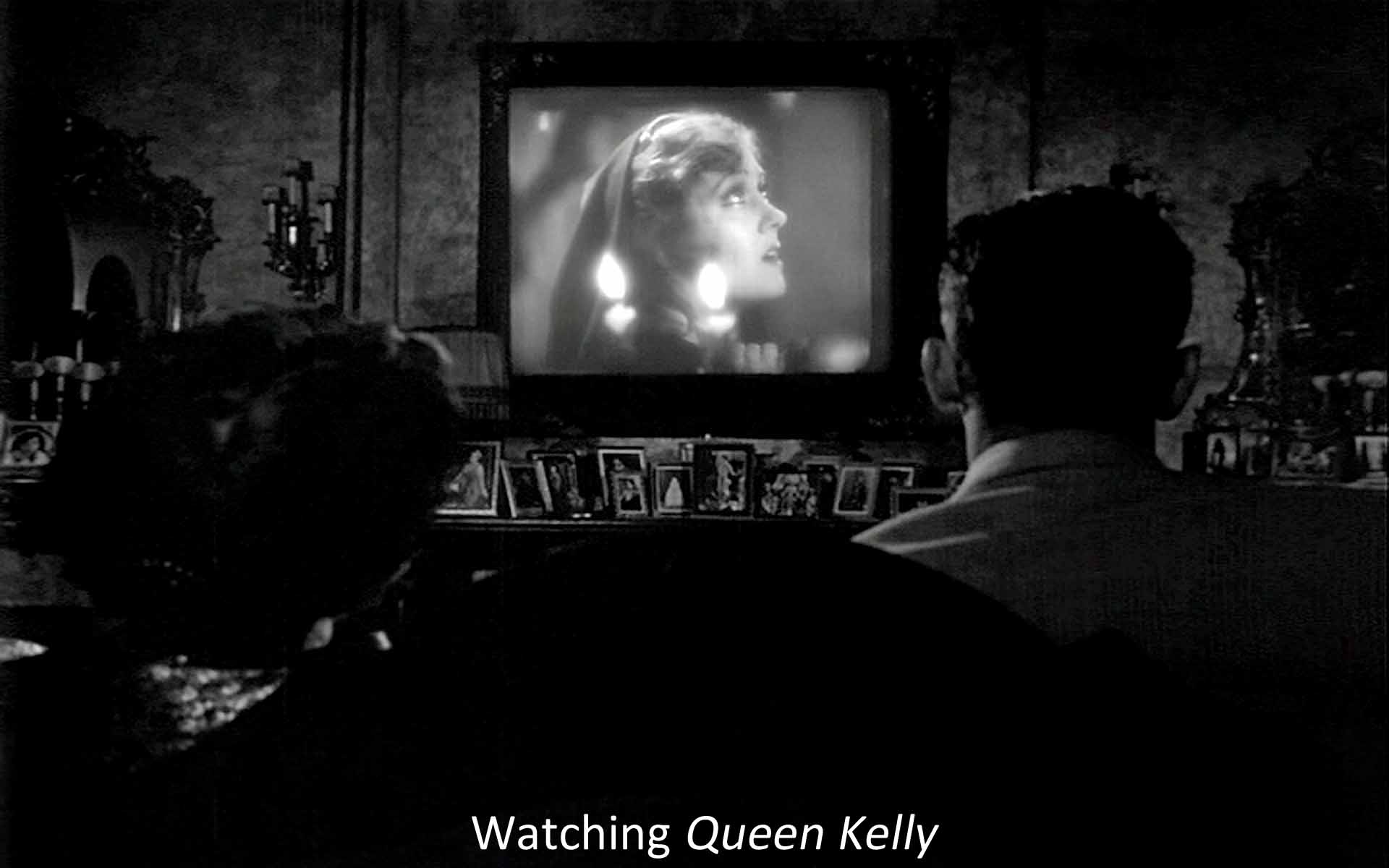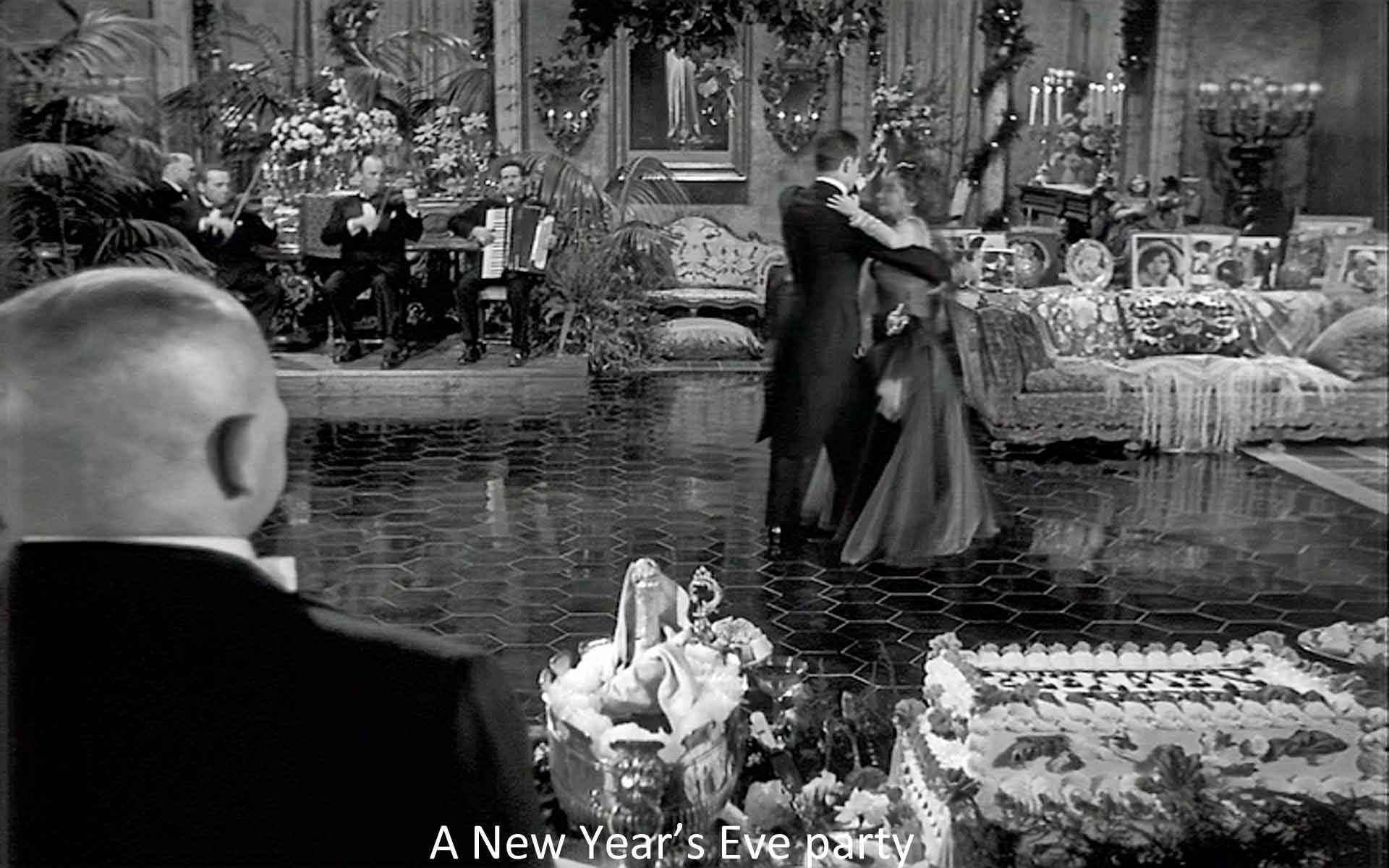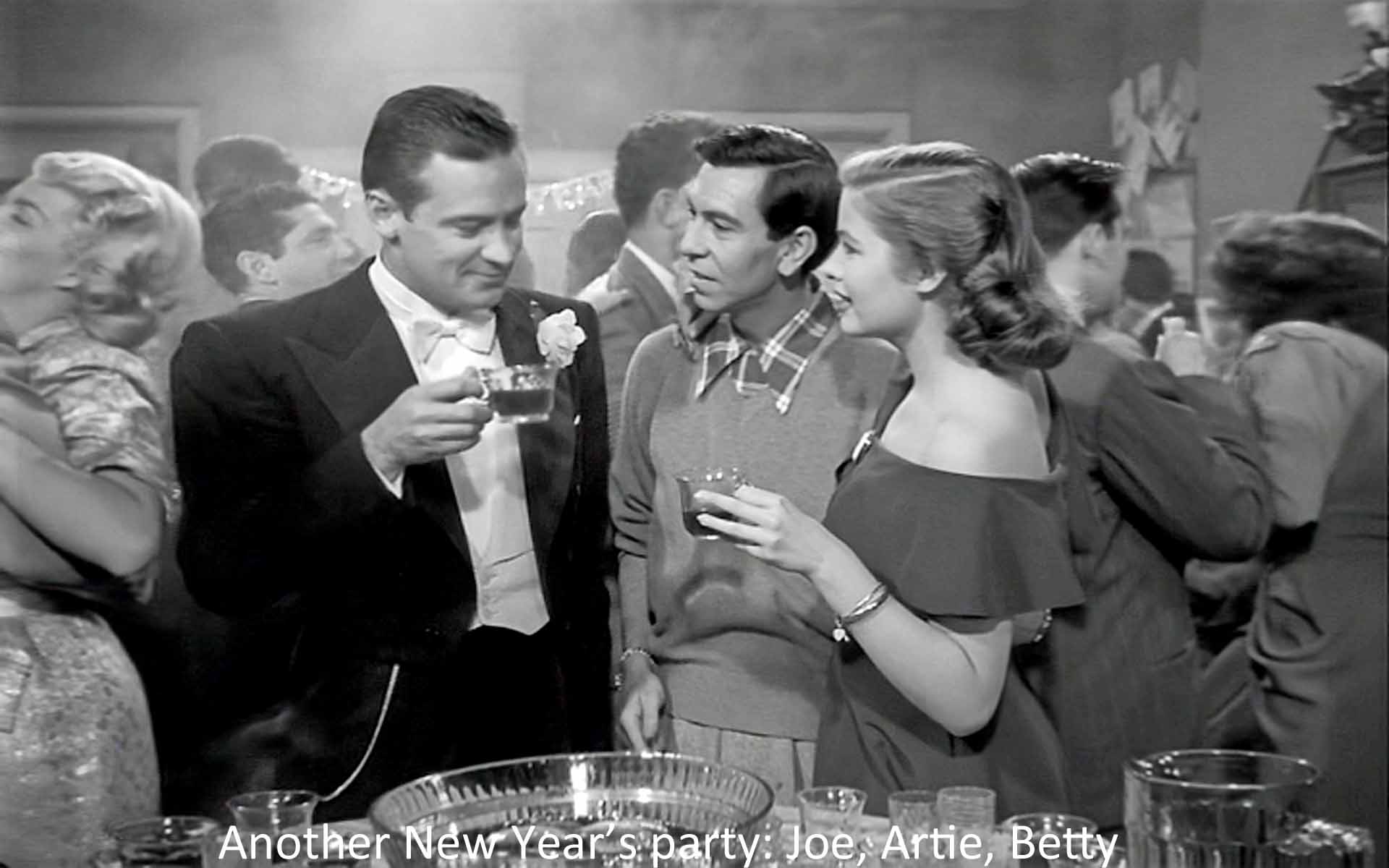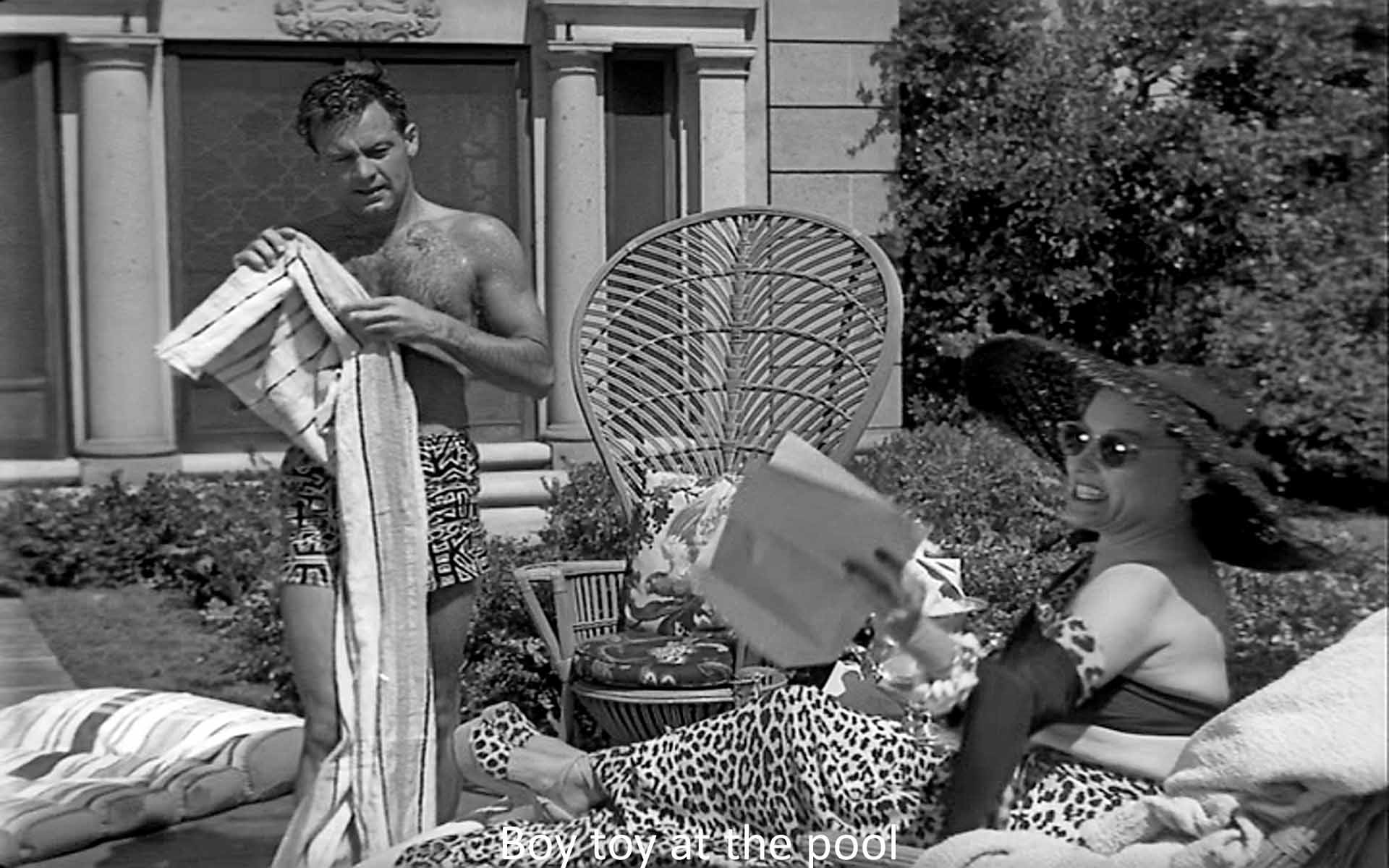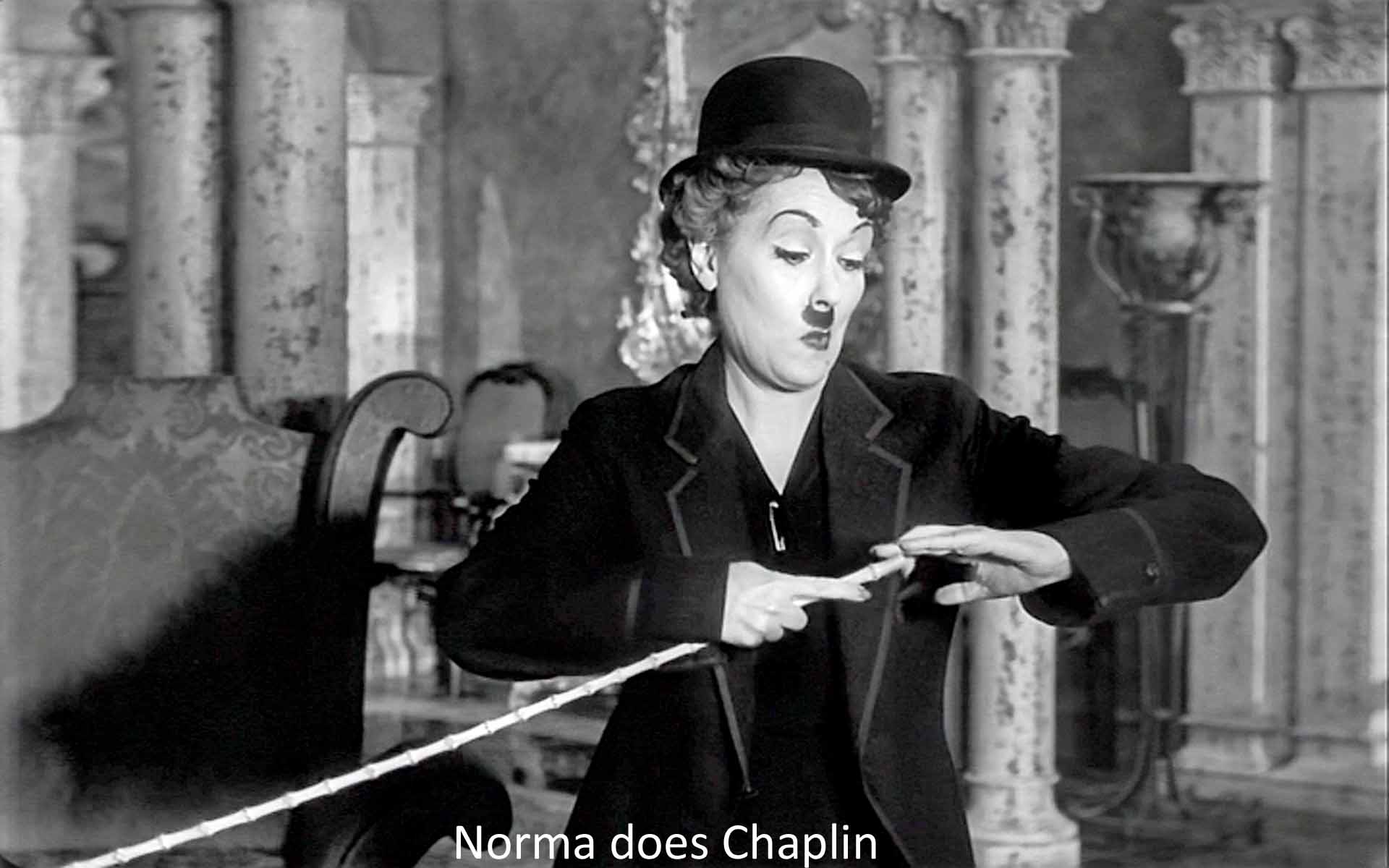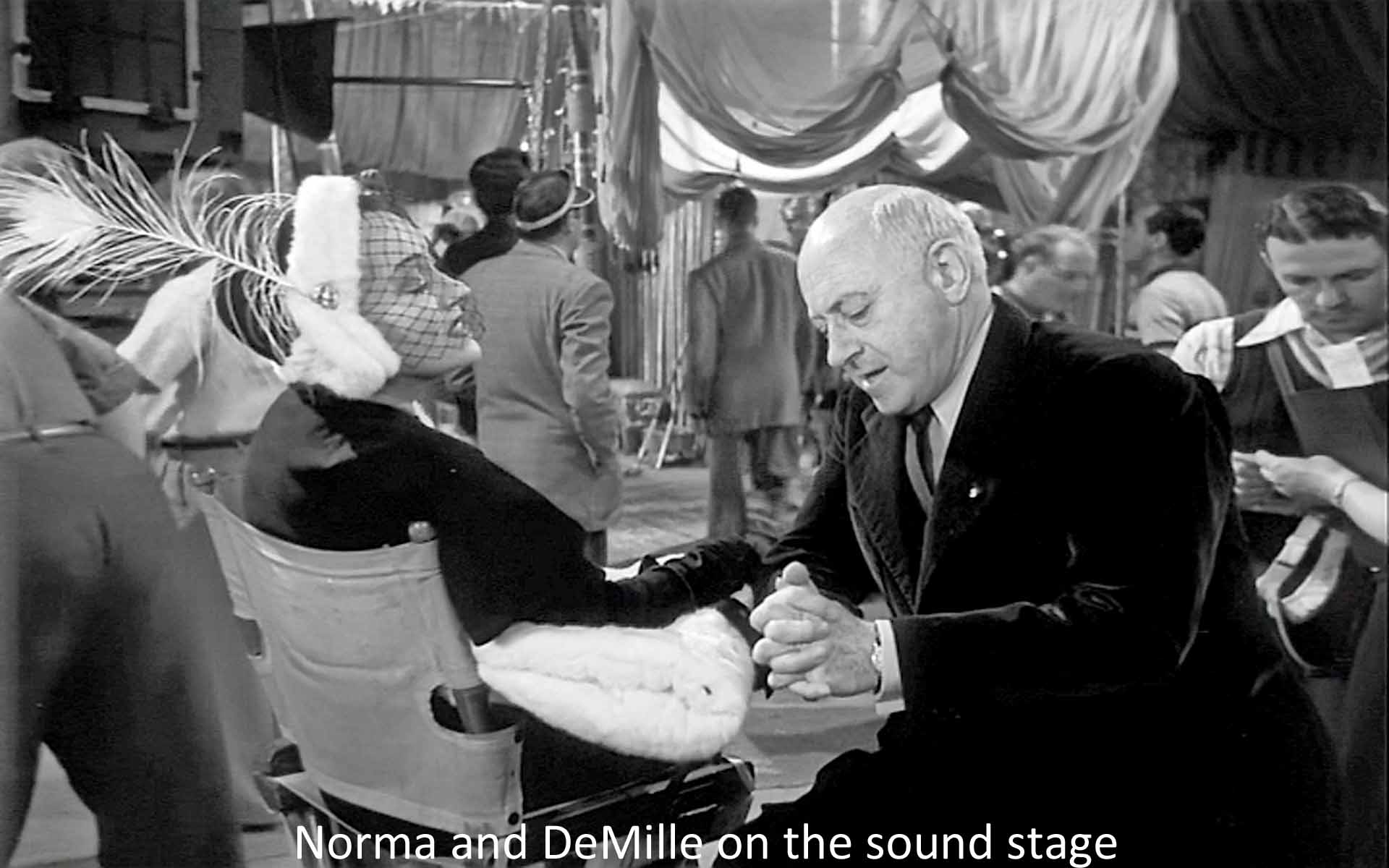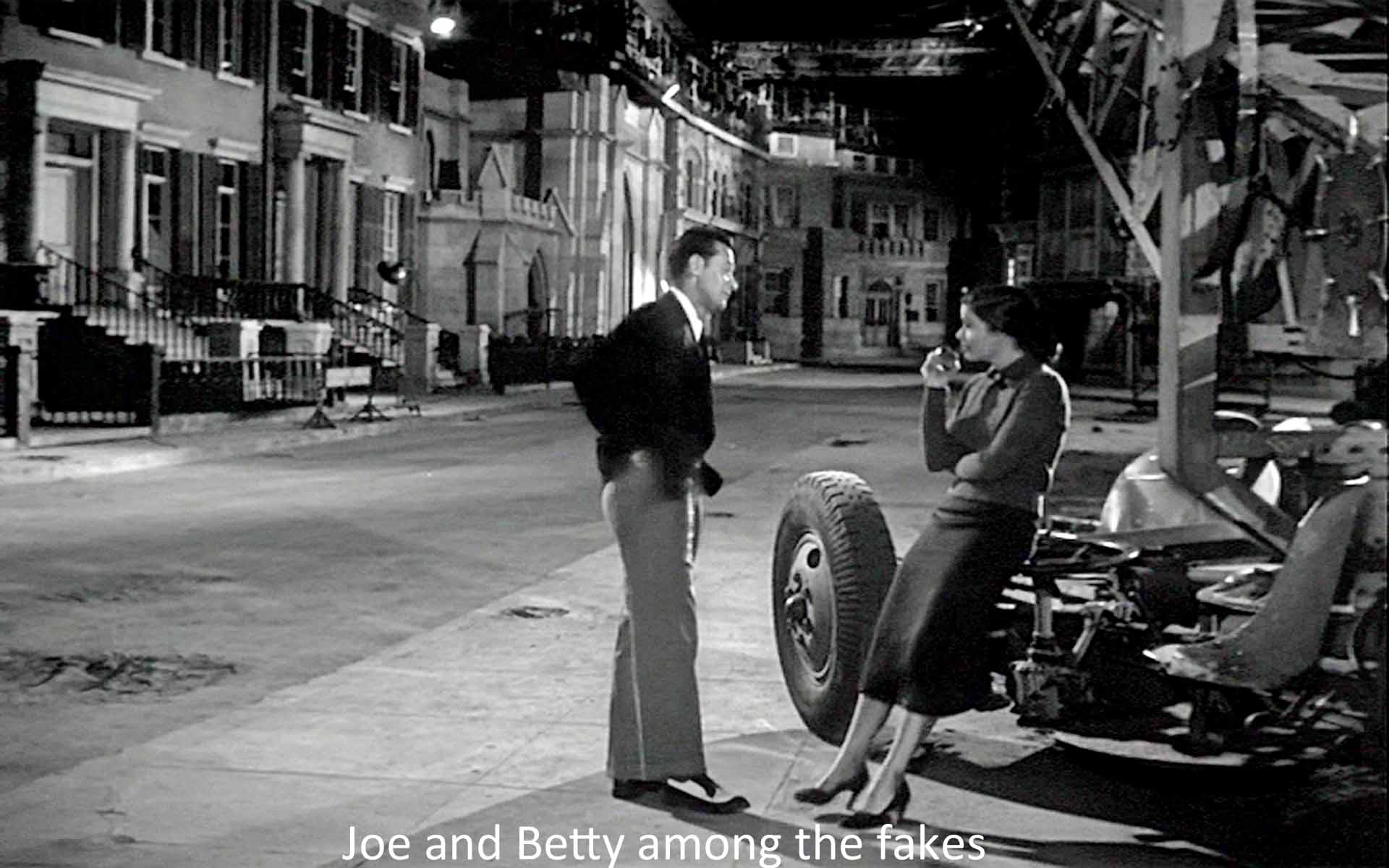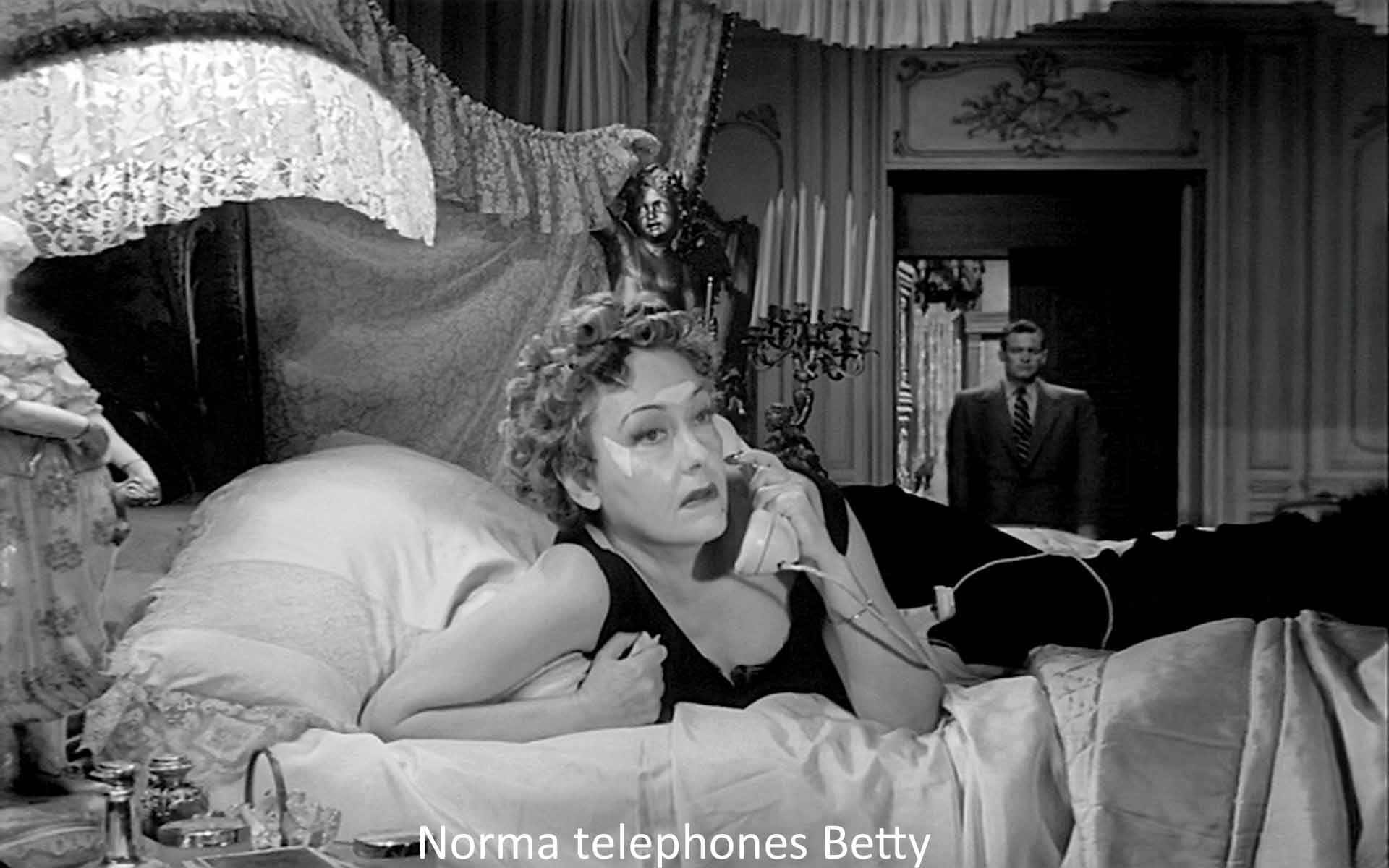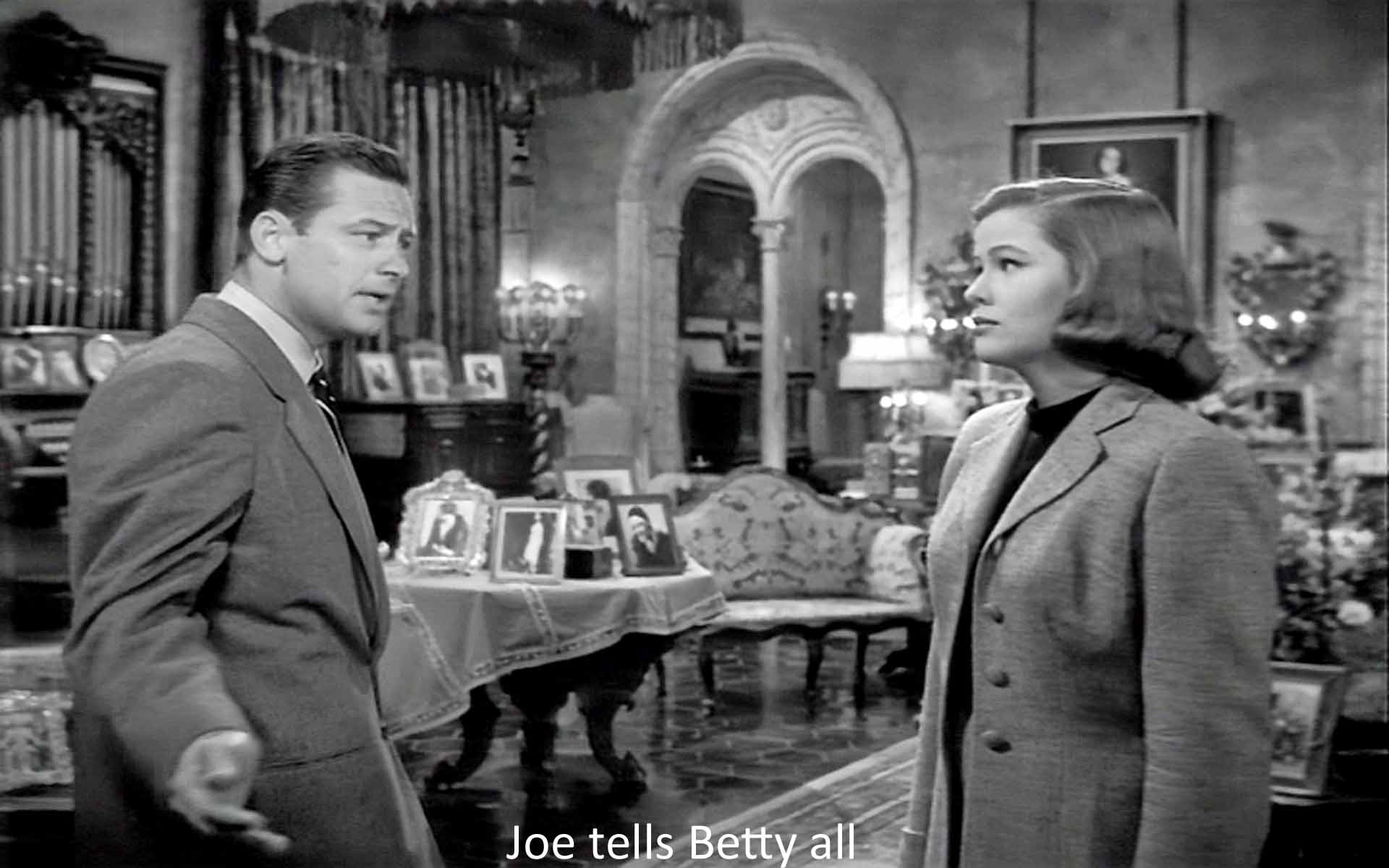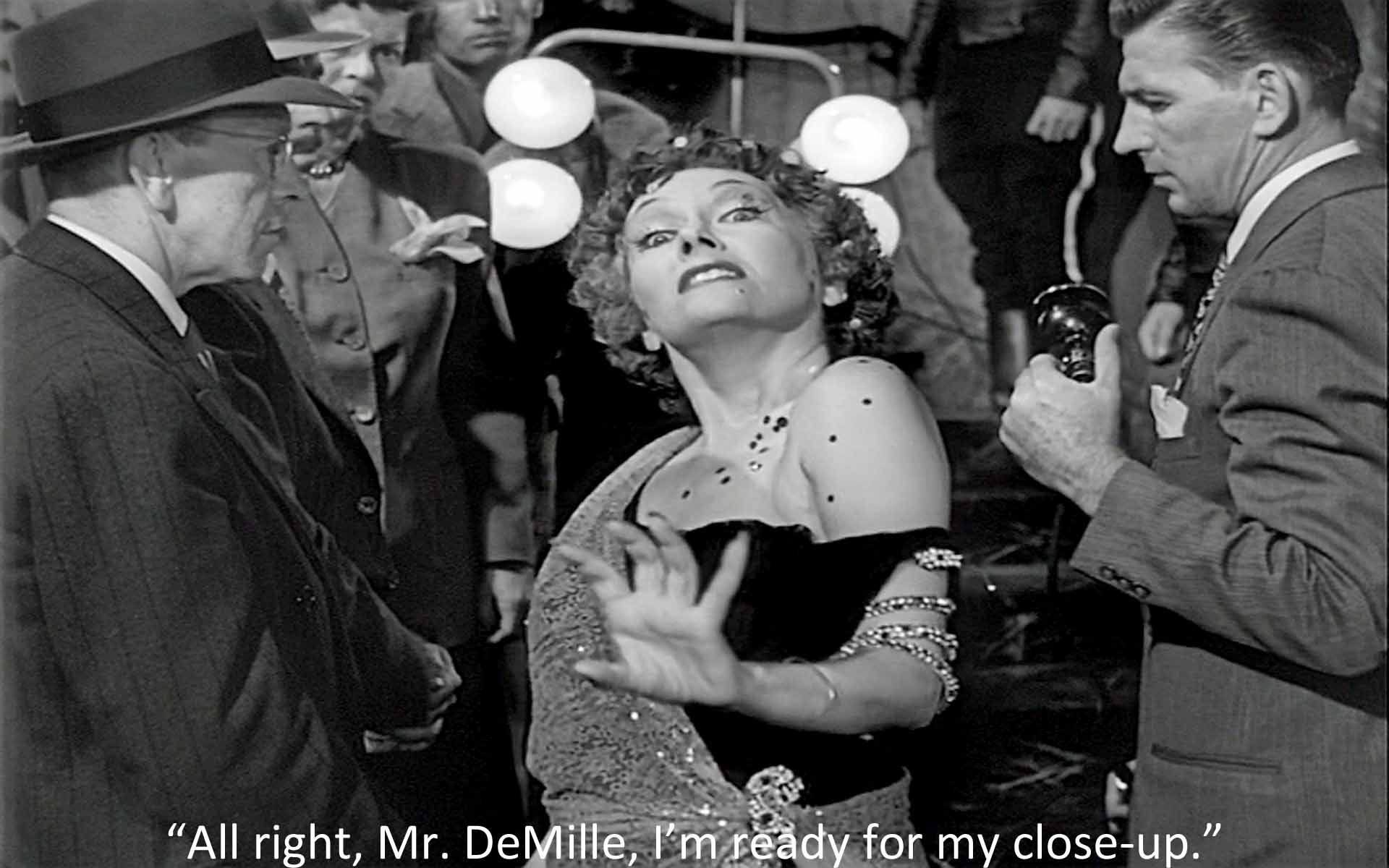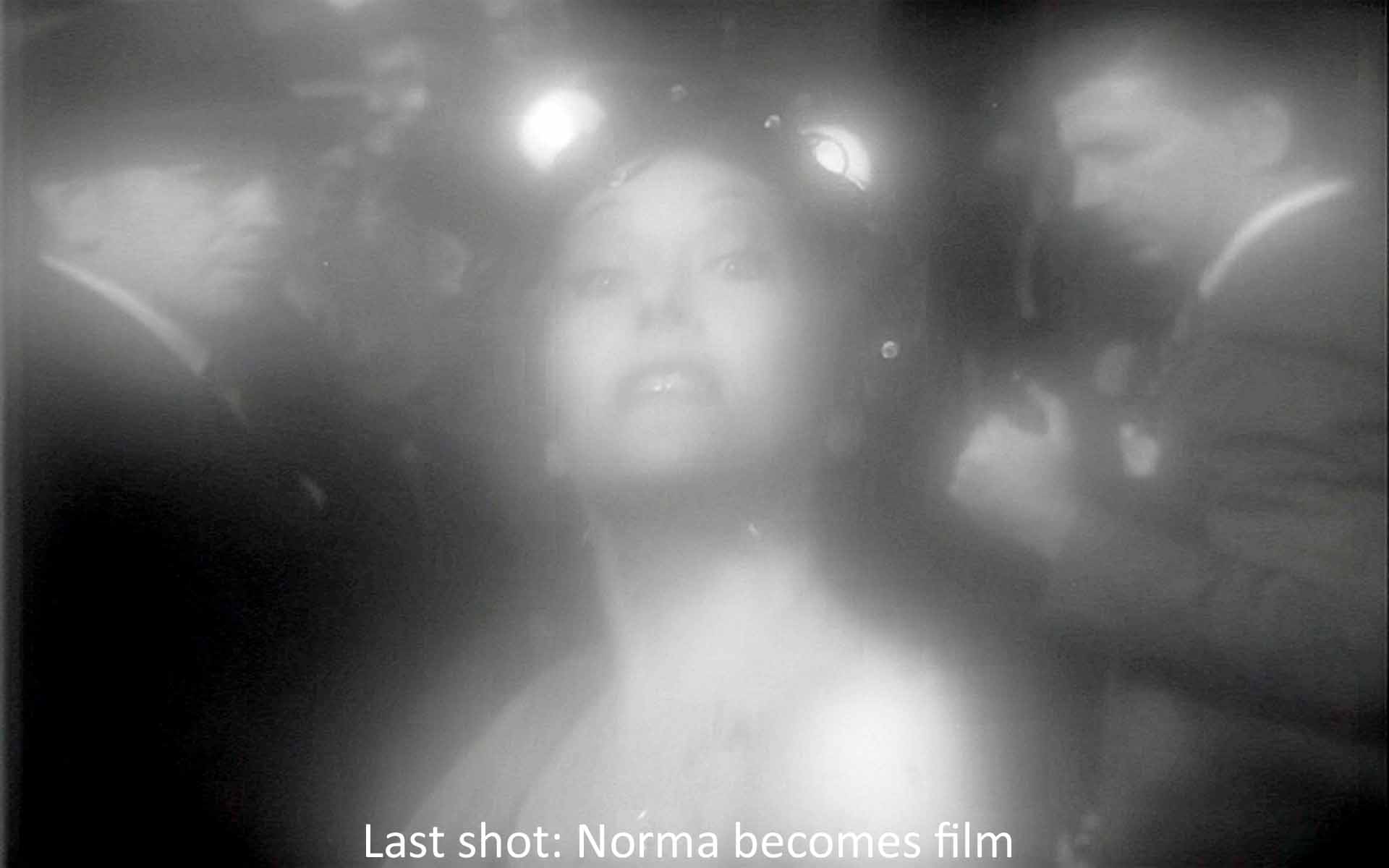Sunset Boulevard is one hard film to write about. I see so many ideas and themes in it that I get tongue-tied or keyboard-tied. That’s the mark of a masterpiece, and this film of Billy Wilder’s surely is for me, at least, a masterpiece.
The obvious place to start is at the beginning, the sequence just after the first shot, repeated as the picture winds down. We see the protagonist floating face down in a swimming pool. (Billy Wilder and cinematographer John Seitz were able to shoot from above the water by putting a big mirror on the bottom of the pool and using lots of light.) The shot echoes the ending of The Great Gatsby, and that tells me that this is a quintessentially American film. We live in a consumerist society that casually uses up things and people and throws them away. That’s how “thirty million fans” have discarded silent screen actress Norma Desmond. That’s why the very first shot, even before the swimming pool, shows a gutter with dead leaves in it.
Norma Desmond (wonderfully done by Gloria Swanson) has written a script based on Oscar Wilde’s Salome with which she will, she feels confident, return to the screen and millions of adoring moviegoers. There was of course, a silent film of Salome (Bryant, 1922). How could there not be? Based on Oscar Wilde’s play, it starred the great silent actress Nazimova. There were earlier ones, primitive in 1907 but rather elaborate in 1908 (Blackton). And there have been a slew of Salome movies since, the last in 2013. But Norma’s idea that she will make a triumphant return to the screen in the role is quite mad. That doesn’t stop her from trying, though.
By chance, Joe Gillis (William Holden), a loser of a screenwriter, hides his car from a couple of repo men in Norma Desmond’s garage. Desmond lives in a huge decaying mansion where she still preserves 1920s style. She is kept going by her devoted butler “Max,” Max von Mayerling (Erich von Stroheim). On learning that Joe is a screenwriter, she “hires” him to work on her script. (Joe gets no money, but room, board, lots of 1920s style luxury clothes, and ultimately sexual duties.) While this is going on, Joe is beginning to write a script with Betty Schaefer (Nancy Olson), engaged to his best friend Artie (Jack Webb), an assistant director. Eventually, though, she falls in love with Joe. He tries to leave Norma—and that effort lands him, no pun intended, in the swimming pool.
The pool sequence turns the film inside out, as Joe Gillis begins the narration that carries the whole picture. Billy Wilder’s strange tactic poses a major question: how can a dead man be narrating the film for us? “But before you hear it all distorted . . . maybe you’d like to hear the facts, the whole truth . . . ” How can we hear the whole truth from a dead man? The film is telling me from the get-go that I am in the realm of fantasy and illusion—just as Norma Desmond lives in hope that she can return to the screen and do so in the style of the silents.
And surely that is one major theme in Sunset Boulevard: illusion, chiefly Norman Desmond’s vain hope that she, a fifty-year-old woman, is going to make a “return” (not a “comeback”!) to the screen doing Salome’s dance of the seven veils. And Joe Gillis has his illusion, that he can somehow write a salable screenplay with his proto-girlfriend Betty. The whole film consists of illusions: Betty’s that she can have Joe; Artie’s that he will have Betty; Max’s that he can keep Norma going; producer Sheldrake’s ulcer-ridden hope of finding a script for Paramount’s bankable contract players, and so on. Then there is the film DeMille is creating, Samson and Delillah. The greatest illusion of all is just “movies.”
This whole film is about the illusions created by movies, including the illusions created in us. Norma in her last triumphant speech calls us “those wonderful people out there in the dark.” And, of course, we are “in the dark,” waiting for the movie, even the dead Joe Gillis!, to tell us what comes next.
Norma’s final, triumphant scene, of course, undercuts illusion. As Billy Wilder surely intended and every critic who writes about this movie has noted, in her last mad descent down the staircase to the waiting newsreel cameras and her old-time director, Norma quite literally returns to the screen. Gillis may be dead in the pool but he does indeed tell truth, at least the “truth” of a movie. We know that we, too, are hovering as Norma is between illusion and reality. We have, in the classic phrase, suspended our disbelief, and for the 110 minutes of the film we believe in Norma Desmond, Joe Gillis, Max von Mayerling, Betty Schaefer, and all the rest.
This film is all about illusions, but it has bits and pieces of reality tucked into it. It has a lot of references to then-living stars: Alan Ladd, Bing Crosby, and Betty Hutton. And real people appear in the film, Cecil B. DeMille, Hedda Hopper, or the silent stars around Norma’s bridge table: H. B. Warner, Anna Q. Nilsson, and the sublime Buster Keaton. Then there is the film we see Cecil B. DeMille in the “real” (actually, reconstructed) process of creating on a sound stage, Samson and Delilah (1949). These are realities but wrapped into the greatest illusion of all, movies, and this movie in particular and so made into illusions themselves.
Illusion is one word that describes this film (and all films). Another is performance. Everyone in this film is performing (except, perhaps, for Joe Gillis’ agent who isn’t doing anything but “making with the golf sticks.” Betty is performing as a “reader,” and the producer Joe pitches to, Sheldrake (Fred Clark), is performing as a producer: he’s looking for screenplays for Bing Crosby or Betty Hutton or Alan Ladd (real performers pulled into this fictional film). Joe is performing as a writer, or trying to, and he ends up performing in Norma’s bed. And she, of course, is performing all the time—rolling her eyes, clutching with her hands, posturing, and, in general, chewing the scenery. She acts—lives, really—in a florid silent-movie style while Holden acts in an understated 1950s way, a nice contrast. In one scene, Norma performs explicitly when she imitates (grotesquely) a Mack Sennett bathing beauty or, with great skill, Charlie Chaplin. (Ironically, in real life Swanson vigorously denied she had ever been one of Sennett’s Bathing Beauties.)
This performance theme may be the reason for the dead chimp in the beginning. Norma admits Joe to the house because she thought he was the undertaker coming to bury the chimp. (Talk about a Lubitschian “meet-cute”—being mistaken for the undertaker for a dead ape.) Perhaps we are to think of “monkey see, monkey do,” i.e., performance or that he is dead as, in a sense, Norma is. He is part of the overdone stage set Norma keeps around her, a creature who apes, like Norma herself, like Gloria Swanson, William Holden, and the rest of the actors in this film. He is a dead performer, whose performance is to be replaced by the man Norma thinks is his undertaker, Joe. And Joe will end up a dead performer, too.
We see some actual live performers, though, when Norma visits the (real) Paramount Studio. Unrecognized by a guard at the gate, she snaps, “Without me there wouldn’t be any Paramount Studio.” DeMille welcomes her, calling Norma “young fellow” as he had called the young Gloria Swanson. He invites Norma to sit in his chair and watch him create one of his (trashy) biblical epics. She does so and a sound boom brushes the feather in her hat. Indignantly she swats it away, she who like so many others was trashed when sound came. In a touching moment, Hogeye, a gaffer high up in the sound stage (another real person), recognizes her and swings his light around to shine on her. Immediately she is surrounded by a worshipful crowd of extras and crew, some her age, some younger. These are performers, too. As is DeMille who curtly says, “Turn that light back where it belongs.” Time (= cost) trumps everything.
The moment summarizes a recurring pattern in studio history. The studio builds up a star, then dumps him or, more frequently, her to become an answer in trivial pursuit games. Jodi Brooks has suggested that the industry itself symbolized the passing of the old studio system or the end of the silent era by evolving an aging actress genre: Sunset Boulevard (Wilder, 1950), Whatever Happened to Baby Jane? (Aldrich, 1962), All About Eve (Mankiewicz, 1950), and The Killing of Sister George (Aldrich, 1968).
The pattern started with Florence Lawrence. She was the first film actor to be named in the screen credits, thus inaugurating the “star system.” After stardom, though, she was discarded and, sick and impoverished, eventually suicided by swallowing cough syrup and ant poison. Or Veronica Lake, the blond idol of my boyhood. She ended up obese, alcoholic, and waitressing. Or John Gilbert, one of the greatest of silent stars. Louis B. Mayer killed his career, and Gilbert became an alcoholic and died at 36. Within the illusion of Sunset Boulevard Wilder develops a real tragedy, the coming of sound. Many a great face and name got dumped into the whatever-happened-to bin because of a squeaky voice (Norma Talmadge, Dolores Costello) or an unfortunate accent (Pola Negri). They were simply thrown away, as Norma Desmond was.
Wilder worked within the studio system (the same system that was used to make Ford cars). He too was dumped by it, but not by the time of this movie. He created in Sunset Boulevard a scene of actual filming. DeMille had just finished making Samson and Delilah at the time Billy Wilder was making Sunset Boulevard, but Paramount recreated one of his sets on a sound stage for the Wilder picture. We see the behind-the-scene lights, cameras, sound booms, extras, and all the rest that contribute to the making of the great illusion.
Sound brought with it sound stages like the one we see, and sound connects to another theme in this film: words and images. Or, As Norma Desmond grandly puts it, “We didn’t need dialogue. We had faces.” And so they did. Many critics and film historians regard the decade of the 1920s, the last decade of the silents, as the high point of movies. Be that as it may, Joe Gillis puts this theme front and center early in the film when he says, “Audiences don’t know somebody sits down and writes a picture. They think the actors make it up as they go along.” Illusion triumphs.
He and Betty are writing a picture with true-to-life dialogue and no queens or princes like those that populated the movie of Norma’s that we briefly see. “This story is about teachers—their threadbare lives, their struggles.” Indeed when Joe and Betty meet at her fiancé’s New Year’s party, they make fun of the stilted dialogue of those old-style movies, the movies Norma would have made had she survived into the sound era. But she didn’t survive. She is, in effect, living in a mausoleum, that huge house of hers (once owned by billionaire oil magnate J. Paul Getty but now in real life, torn down—more discarding, more reality-in-illusion).
That mansion could easily be the setting for a horror movie. The film noir style helps, the dark interiors and the night scenes. Then there’s the preoccupation (characteristic of noir) with cars, first Joe Gillis’, then Norma’s magnificent Isotta-Fraschini, upholstered in leopard skin to match her get-up. Norma is the witch in her castle, luring unsuspecting men in. She brandishes her claw-like hands and rolls her eyes melodramatically. She has a silent, menacing servant (like Frankenstein’s Igor). No locks on the doors. Rats in the swimming pool. A dead chimp buried in the garden. An organ that plays itself. Dim light, dust and disuse, ancient furniture, an ominous staircase. There are ghosts who flit through the castle, “the waxworks” as Gillis calls them, the weekly bridge game, four silent stars whose careers—whose lives—have also ended. And the secrets: Max as her first director, her first husband(!), but now her fanatically devoted butler. The witch purrs and lures the young hero into her lair. He thinks he has outfoxed her, but it she who overpowers him. She entices him, traps him, and eventually kills him. Norma is thereby enacting one of Billy Wilder’s favorite theme, a man seduced by an intelligent woman.
Norma is the living dead, a zombie. But isn’t that the great power of movies? They can bring the dead back to life. When my DVDs play, I can see the dead perform. Movies have a kind of creepy, supernatural power over life and death and what we believe and who the characters onscreen are.
Nancy Steffen-Fluhr has made a convincing case that Wilder is haunted (and therefore his movies, too) by the idea of the living dead as derived from the horror film classic Nosferatu (Murnau, 1922) but also the Holocaust. (Wilder edited the first footage from the Nazi death camps.) Hence he gives us the dead narrator and Norma’s defunct style of life—the living dead and the horror movie feel of Sunset Boulevard, amplified by John Seitz’s cinematography.
He and Wilder condensed many events in Swanson’s and Desmond’s life into a single scene. Norma and Joe watching one of her old movies is a marvel. The film was Queen Kelly (1929) in which Swanson herself starred and which von Stroheim himself directed. In the story a crazy queen forces a playboy prince to marry her, somewhat as Norma Desmond forces Joe Gillis into becoming her lover. Swanson played a convent girl who drops her underwear during a religious procession to attract the prince. The producer of the film was Joseph Kennedy, JFK’s father and Swanson’s lover at the time. The film, caught in the advent of sound, was an expensive flop and put a serious crimp in both Swanson’s and von Stroheim’s careers. She herself wrote a different ending, trying to salvage it. Now in the public domain, it is available online. In showing this clip, cinematographer John Seitz put dust in the light beam from the projector to make the film’s and its star’s disuse and decay visible. The shot used in Sunset Boulevard shows the softened pictorial style of many silents—vaseline on the lens—that enhances Swanson’s beauty. Joe and Norma see a title card that says, Cast out this wicked dream which has seized my heart. Isn’t that precisely Norma’s problem, the wicked, foolish dream that she can be a star again, eternally young, beautiful, adored?
What is a “star”? Once the star was just somebody from Brooklyn or Topeka or somewhere with some talent and something special (usually a way to attract lights and camera on the set). But the studio publicity machine pads this person out until he or she becomes something almost supernatural, something unforgettable. And to be that person, to be the god or goddess, is heady stuff indeed. No wonder Norma Desmond is as batty as she is. And then to have it all go away.
I remember a phrase from an article on stardom that I read long ago: the star is “imperfectly submerged” in the part. James Stewart in Vertigo is both detective Scottie Ferguson and James Stewart. Vivien Leigh is Scarlett O’Hara but doesn’t stop being Vivien Leigh. So here, Gloria Swanson is both Norma Desmond, a character in a Billy Wilder movie, and Gloria Swanson a famous star of the silents. And so, in a less grand way, Joe Gillis/Bill Holden and Betty Schaefer/Nancy Olson have double identities.
That is another of Wilder’s favorite themes, masks and identity. But Sunset Boulevard plays even more with a third Wilder theme: things and people being in the wrong place or time. In the first act, Joe Gillis puts his car in various wrong places, but none wronger than Norma Desmond’s garage. Then we see Norma Desmond’s living in the past, wrong time. Joe tries to get away from her and get to a place that’s right for him, Artie’s New Year’s party of young people struggling upward like himself, but Norma’s newest suicide attempt draws him back into a wrong place, the haunted mausoleum. It’s touching that Joe and Betty play out their one real love scene in front of a row of fake houses. “All cardboard,” she says, “all hollow, all phony. All done with mirrors. I like it better than any street in the world.” Poor, deluded Betty finally confronts Joe in Norma’s haunted house—a very wrong place for her and, as it turns out, for him. And Norma, in her last magnificent scene, is in one place, her haunted house, but she thinks she is in another, the Paramount studio. The most obvious wrong place, though, is Joe Gillis in the swimming pool at the beginning and end of the picture.
The repetition of the shot of Gillis dead in the pool paves the way for Norma’s grand final speech. Gillis in voice-over says: “The dream she had clung to so desperately had enfolded her . . . ” She is now completely mad. She takes the newsreel cameras for studio cameras. She believes poor Max is DeMille, a final indignity for him, since Demille went on to great success as a director while Max sacrificed his career for Norma. So too von Stroheim crashed. Norma delivers a partly sane farewell, one worthy of grand opera. She addresses the people who make movies, the people who have both loved and dumped her. “I promise you I’ll never desert you again, because after Salome we’ll make another picture, and another and another. You see, this is my life. It always will be. There’s nothing else—just us and the cameras and those wonderful people out there in the dark.” Her life—she is enfolded in the dream world of movies. And we are in there, too, in the dark, both literally and figuratively, waiting to be told what comes next. What comes next is one of the most famous and wonderful lines in all moviedom: “All right, Mr. DeMille, I’m ready for my close-up.” And close-up it is. Wilder and Seitz bring the camera in and in and blur her until she becomes film itself. “This is my life. It always will be.”
And so it was for Wilder. Sunset Boulevard was the peak. He made many fine movies and came to be regarded as second only to Hitchcock among directors. Yet the system shelved him as it shelved Norma Desmond and, for that matter, Gloria Swanson, Nancy Olson, and William Holden. This was Billy Wilder’s masterpiece, and it speaks—wonderfully—for itself. I’ve come to believe that it ranks up there with the very top, Citizen Kane, Vertigo, and now Sunset Boulevard. Screen writing and screen directing don’t get any better than this.
